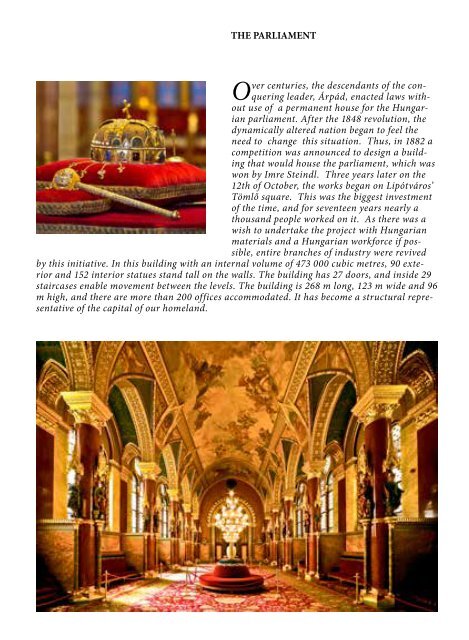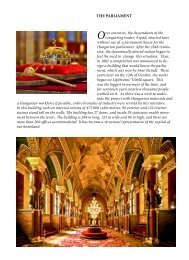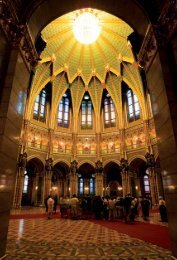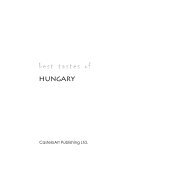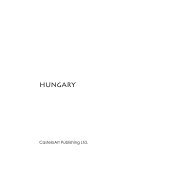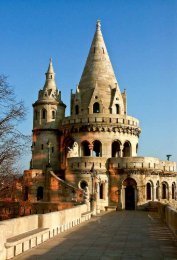Create successful ePaper yourself
Turn your PDF publications into a flip-book with our unique Google optimized e-Paper software.
THE PARLIAM<strong>EN</strong>T<br />
Over centuries, the descendants of the conquering<br />
leader, Árpád, enacted laws without<br />
use of a permanent house for the Hungarian<br />
parliament. After the 1848 revolution, the<br />
dynamically altered nation began to feel the<br />
need to change this situation. Thus, in 1882 a<br />
competition was announced to design a building<br />
that would house the parliament, which was<br />
won by Imre Steindl. Three years later on the<br />
12th of October, the works began on Lipótváros’<br />
Tömlő square. This was the biggest investment<br />
of the time, and for seventeen years nearly a<br />
thousand people worked on it. As there was a<br />
wish to undertake the project with Hungarian<br />
materials and a Hungarian workforce if possible,<br />
entire branches of industry were revived<br />
by this initiative. In this building with an internal volume of 473 000 cubic metres, 90 exterior<br />
and 152 interior statues stand tall on the walls. The building has 27 doors, and inside 29<br />
staircases enable movement between the levels. The building is 268 m long, 123 m wide and 96<br />
m high, and there are more than 200 offices accommodated. It has become a structural representative<br />
of the capital of our homeland.
2
3
BUDA CASTLE<br />
The history of Buda Castle dates back to the Medieval<br />
period. Construction began in the mid 1300s, the<br />
golden age in the time of King Matthias Corvinus. The<br />
early central palace was severely damaged in the battles<br />
against the Turks, but later, thanks to the initiative of Maria<br />
Theresa, it was renovated in a majestic baroque style. Unfortunately,<br />
the palace fell victim to the Second World War,<br />
and at present it does not retain any parts which would<br />
reflect the luxury of the bygone kings.<br />
4
Reconstruction work on the palace started in 1959 on a<br />
rather tight budget. A simpler design was implemented<br />
and instead of reconstructing the ornate halls, modern<br />
and puritan architectural options were chosen. Today,<br />
it has an important role in the country’s culture since<br />
its chambers are used by the Hungarian National<br />
Gallery, the National Széchenyi Library, the Ludwig<br />
Museum of Contemporary Art and the Historical Museum<br />
of Budapest. It is home to numerous traditional<br />
events, including the Crafts Festival and the Buda<br />
Castle Wine Festival. The Buda Castle Palace as part<br />
of the Buda Castle Quarter has been designated as a<br />
world heritage site since 1987. Hundreds of thousands<br />
of tourists from all parts of the world visit every year.<br />
Numerous sights and points of interest are on offer for<br />
them. These include the Buda Castle Labyrinth, the<br />
old narrow streets and cosy restaurants of the Castle<br />
Quarter. Thanks to the location of the Palace, one can<br />
enjoy a wonderful panoramic view over the city of<br />
Budapest.<br />
5
MATTHIAS C<strong>HU</strong>RCH<br />
M<br />
atthias Church, with the official name of<br />
Buda Castle Church of Our Lady, has occupied<br />
a prominent place in Hungarian history from<br />
the beginning. According to ecclesiastical tradition<br />
it was founded in 1015 by St Stephen. According to<br />
written records it was known in the 17th century as<br />
St Stephen’s church. The church had been standing<br />
for centuries when our King Matthias had a<br />
tower built onto it. During this period the church<br />
attained the peak of its mediaeval prosperity. King<br />
Matthias and the great historic figures following<br />
him had their weddings here, and Queen Elizabeth<br />
too and Charles I, the last crowned Hungarian<br />
king, also took their oaths in this holy place. The<br />
building suffered severe damage in World War II.<br />
Reconstruction work was begun in 1950 and the<br />
finishing touches were completed in 1984. For the<br />
first time in the history of the church, the state gave<br />
it into the possession of the Church in 1999, and<br />
even today this place of holy pilgrimage occupies a<br />
position worthy of its rank on Holy Trinity Square<br />
in the vicinity of Buda Castle Palace, providing a<br />
home for sung High Mass and welcoming visitors<br />
with open doors.<br />
6
<strong>HU</strong>NGARIAN STATE OPERA HOUSE<br />
S<br />
eptember 24, 1884<br />
was the long opening<br />
of the Budapest Opera<br />
House, and the great<br />
opening celebration was<br />
enhanced by the presence<br />
of Karl Franz Jozef.<br />
The awaiting crowd of the Sugár road was so excited to see the interior that they swept aside<br />
the guarding policemen and ran into the palace-like institute. Although, the name of the<br />
road has since been changed, the building is still beautiful and is a favourite of opera lovers.<br />
7
GUNDEL RESTAURANT<br />
T<br />
he word Gundel is synonymous with tradition<br />
and quality in the area of hospitality.<br />
The founder of the restaurant, Károly Gundel<br />
felt it was his goal to gather the values and<br />
specialities of Hungarian gastronomy and to<br />
amalgamate these with modern gastronomic<br />
techniques used in other parts of the world.<br />
With his persistent, popularising work he succeeded<br />
in putting Hungarian cuisine on the<br />
world gastronomy map. Looking back on a past<br />
of more than 100 years, the Restaurant has survived<br />
the storms of history, the world wars and<br />
the changes of regime, and at present is proudly<br />
continuing the work of the founder. It has won<br />
numerous national and foreign accolades. The Gundel Restaurant is popular with both Hungarians and<br />
foreigners, the secret of which is the milieu surrounding the guests, the inimitable hospitality, the tradition<br />
which radiates from the building and environment, and the food compositions prepared from outstanding<br />
quality ingredients. The Gundel Artistic Prize was created at the turn of the millennium, which<br />
is assigned each year in 14 categories for the purpose of acknowledging the best in various branches of the<br />
arts and in order to support their work. Since 2010 the chairman has been Miklós Szinetár, Kossuth prize<br />
winner, twice Mari Jászai prize winner and director of theatre, opera, TV and film.<br />
8
GREAT / C<strong>EN</strong>TRAL MARKET HALL<br />
Aiming at ceasing the noisy and dirty<br />
outdoor markets, the City Council<br />
established the Central Market Hall. The<br />
stately neo-gothic building was handed<br />
over to the traders in 1897, and almost<br />
at the same time, four other market<br />
halls were built on the Pest side. The<br />
building is one of the finest creations<br />
of historicism in Hungary, built to the<br />
designs of architect Samu Pecz together<br />
with the neighbouring University of<br />
Economic Sciences. The building has a<br />
ground space of 10 000 square metres,<br />
the roof is adorned with building ceramics<br />
from the famous Zsolnay works,<br />
the stone entrance gates represent the<br />
Neo-Gothic style. The building was declared<br />
a monument in 1977, which was<br />
magnificently renovated at the end of<br />
the 20th century. In 1999 it was awarded<br />
the most prominent accolade of the<br />
Chamber of Hungarian Architects. This<br />
wonderful building is still in operation<br />
as a market hall today, welcoming thousands<br />
of local and foreign shoppers and<br />
visitors with a colourful selection.<br />
9
HEROES’ SQUARE<br />
All the lamp posts are facing a peculiar monument<br />
on the Hősök tere (Heroes’ square). It is<br />
the millennial monument which commemorates<br />
the thousandth anniversary of the original settlement<br />
of the Hungarians. The monument depicts<br />
the heroes who made Hungarian history with their<br />
deeds. A Gloriette designed by Miklós Ybl stood<br />
here in 1894, which also incorporated a drinking<br />
fountain. The Gloriette was short lived, as in the<br />
year following its placement the decision was made<br />
to build a Pantheon on its site for the Millennium<br />
celebration. Sculptor György Zala and architect<br />
Albert Schickendanz were commissioned with<br />
implementing the task. Statues of 14 Hungarian<br />
rulers stood in the original monument. The square<br />
was later named Heroes’ Square in 1932. During<br />
the communist dictatorship following World War<br />
II, the statues were refashioned in accordance with<br />
the political views of the age, so the statues of the<br />
Habsburg monarchs were replaced. Although the<br />
country has been liberated from the dictatorship,<br />
the statues of the Habsburgs have still not been<br />
returned to their original positions.<br />
10
11
<strong>HU</strong>NGARIAN NATIONAL MUSEUM<br />
The idea of founding the museum emerged in<br />
times when the national consciousness and the<br />
notion of freedom were both becoming apparent<br />
among civilians. In 1802, Ferenc Széchenyi, wanting<br />
to grant his rich collection to the Hungarian<br />
nation, asked the permission of the ruling Ferenc I<br />
who, of course, supported Széchenyi’s idea. Later,<br />
the 1832-36 Hungarian Diet carried a motion to<br />
build an independent house for the museum. The<br />
appropriated sum was half a million Forints, and<br />
the professionally recognized Mihály Pollach became<br />
entrusted with the designs . His work was finished<br />
by 1847, and the place had a significant role in the<br />
1848-49 war of independence. The revolution broke<br />
out after the famous poet, Sándor Petőfi, recited his<br />
poem to the nation while standing on the stairs of<br />
the museum. From that point on, the building became<br />
a museum as well as an emblem of the nation’s<br />
freedom. Nowadays the Museum welcomes visitors<br />
with a permanent exhibition presenting the history<br />
of the Hungarian nation, seasonal exhibitions and<br />
interesting, colourful programmes for both younger<br />
and older people.<br />
12
GELLÉRT HOTEL AND SPA<br />
The history of the Gellért Hotel and Baths goes back<br />
to ancient times. In the 13th century, Andrew II<br />
established medicinal baths and a hospital here. During<br />
the Turkish period a bathhouse named Acsik ilidzse<br />
stood here. Following the reoccupation of Buda it came<br />
into the possession of Leopold I’s family physician,<br />
then in 1718 the ownership passed to the city of Buda.<br />
At that time it was known by the name of<br />
Sárosfürdő. In 1894 it was demolished when<br />
the Franz Joseph Bridge was built. When the<br />
concept of Budapest as a city of bathhouses<br />
was in formation in the early 20th century,<br />
construction of the baths and the hotel once<br />
more came to the fore. The building was<br />
completed in 1918 in breathtaking art nouveau<br />
style and entered public consciousness as<br />
the first luxury hotel and bath in the capital.<br />
It ranked among the most modern medicinal<br />
baths of the age . In line with requirements of<br />
the time, a a hospital was attached . Cuisine<br />
was provided by the world famous Gundel<br />
Restaurant until 1945. It now bears the name<br />
of Danubius Hotel Gellért, which is one of the<br />
best known hotels in Budapest. Preserving<br />
its traditions, guests are still welcomed by the<br />
polite and amiable staff, as they come to enjoy<br />
the pleasures of relaxation in magnificent<br />
surroundings.<br />
13
VISEGRÁD<br />
This picturesque town which celebrated its millennium<br />
last year was the capital of Hungary under<br />
King Charles Robert. The construction of the Upper<br />
Castle was initiated by the wife of King Béla IV,<br />
Queen Mary in the 1250’s, and later it was enlarged<br />
by King Sigismund and King Matthias. The Tower<br />
named Solomon is situated on the hillside beneath<br />
the castle. A fortified military camp once stood here,<br />
14
where King Solomon was held<br />
between 1081-1083 at the command<br />
of King Saint Ladislaus. Visegrád<br />
and the Upper Castle are now tourist<br />
attractions. The town attracts<br />
thousands of tourists from in- and<br />
outside of Hungary annually because<br />
there are great opportunities<br />
for excursions, visiting historic<br />
monuments, reliving the past, and<br />
taking pleasure in the beautiful<br />
sight of the Danube Bend. Visegrád<br />
has also hosted the popular summer<br />
palace games for several decades ;<br />
a unique spectacle in the country.<br />
The games are staged in the in the<br />
dress of the times of King Matthias’.<br />
In the programme spectacular<br />
jousts are performed and the visitor<br />
can even try archery.<br />
15
SZ<strong>EN</strong>T<strong>EN</strong>DRE<br />
At the junction of the mountains and the plain<br />
land, on the bank of the Danube, lies the city<br />
of museums and art, the cultural paradise of tourists,<br />
Szentendre with its more than two thousand<br />
years of history. Its museums, galleries, and cozy<br />
cafes can be approached via streets of cobblestone,<br />
and through narrow alleyways. Szentendre houses<br />
the Open Air Museum of Ethnography, which presents<br />
folk architecture, and the life of Hungary’s<br />
most characteristic regions.<br />
16
ESZTERGOM<br />
Grand Prince Géza chose Esztergom as his kingdom in 972, making it the first capital of our<br />
country. King Saint Stephen was crowned here on 1 January 1001; he founded the archdiocese<br />
of Esztergom as the centre of the Hungarian church. The Basilica of Esztergom, the largest church<br />
in Hungary, was built on the castle hill. This masterpiece was consecrated in 1869, and for that occasion<br />
Franz Liszt composed his Esztergom Mass.<br />
17
HORTOBÁGY<br />
The largest park in Hungary was designated<br />
a national park in 1973. It features<br />
the largest grassland in Central Europe, and<br />
is part of the World Heritage. Hortobágy is<br />
the perfect plain developed from the planation<br />
of the River Tisza, which preserves its<br />
character even today. The ancient Hungarian<br />
Grey Cattle, the managalica swine,<br />
and the Hungarian herd-dogs: the puli and<br />
pumi are held here with the purpose of gene<br />
18
preservation. The symbol of the National<br />
Park is the famous Nine-holed Bridge,<br />
which was the longest public road bridge<br />
in 1833 when it was finished. The herds of<br />
the Debrecen cattle merchants traveled to<br />
Vienna using this bridge in the times of the<br />
Tisza floods. Its unique flora and fauna,<br />
the endless horizon are a genuine spectacle<br />
and great experience for those who like<br />
harmony and nature itself.<br />
19
KARCAG, WORLD FAMOUS LAMB STEW<br />
Nagykunság is located in the middle of<br />
the Great Plains. Its capital is Karcag,<br />
which is the old name for the plains fox.<br />
It is an independent, natural, and cultural<br />
ethnic group with more than 800 years of<br />
tradition. Among the outstanding aspects<br />
of its folk culture are livestock farming,<br />
gastronomy, and pottery. Shepherds have<br />
always had access to the best foods due<br />
to their work, and so over the course of<br />
20
decades and centuries a gastronomy has<br />
developed for these. So there is a very<br />
typical mutton stew that is common,<br />
cooked the same as in Kazakhstan, which<br />
shows that it has a tradition going back<br />
several thousand years. The Karcag lamb<br />
stew rightfully has entered the collection<br />
of Hungarian folk history. The modern<br />
and elegant Nimród Bio hotel and Bio<br />
restaurant is located in the heart of the<br />
city, where there is always food of exceptional<br />
quality and quiet, spacious rooms<br />
await visitors.<br />
21
TOKAJ<br />
According to the written sources, Tokaj was<br />
a vine-growing region in 1067. In 1823 Ferenc<br />
Kölcsey includes the wine region of Tokaj<br />
in his poem – …Tokaj szőlővesszein Nektárt<br />
csepegtettél… (…You were trickling Nectar<br />
on the vines of Tokaj…) – , the poem which<br />
later became the national anthem of Hungary.<br />
22
This charming historic city which has been attracting<br />
tourists for decades is now part of the<br />
World Heritage. Boldogkő Castle was buiild as a<br />
fortress after the Mongol invasion, with the aim<br />
of protecting the Kassai road and Hernád valley.<br />
Today it is a tourist attraction, where a military<br />
history exhibition including soldiers made out<br />
of lead await tourists. In summer it is home<br />
to castle games, where visitors are transported<br />
back in time with horsemen, musical parade,<br />
military exercises and an archery competition.<br />
23
SÁROSPATAK<br />
Sárospatak was already inhabited in Palaeolithic<br />
times; it was given town status in 1201 by King Emeric<br />
of Hungary. Saint Elizabeth of Hungary (Árpádházi<br />
Szent Erzsébet) was born here – she was the daughter<br />
of King Andrew II of Hungary. King Sigismund gave<br />
Sárospatak the status of free royal town, and in 1460<br />
it received the right for markets by King Matthias. Its<br />
24
Calvinist School is famous nationwide. Several famous<br />
persons studied here, among others Mihály<br />
Csokonai Vitéz and Lajos Kossuth. Péter Perányi<br />
began building the castle in 1534, and it was possessed<br />
by several famous noble families in the<br />
centuries to come. Among the owners were István<br />
Dobó and Ferenc Rákóczi II, whose name hallmarks<br />
the castle today The Rákóczi Museum of<br />
the National Museum functions among its walls<br />
at present. Sárospatak is a starting point for numerous<br />
tourist routes and the River Bodrog offers<br />
sporting opportunities as well.<br />
25
MÁTRA, HOLLÓKŐ<br />
H<br />
ollókő is the only village in Hungary<br />
which is a World Heritage site. This<br />
tradition- preserving village with a total<br />
of 380 residents is not in operation as<br />
a museum or a skanzen, but it is a living<br />
village, where functional handicraft<br />
workshops are to be found in the depths<br />
of the whitewashed houses with verandas.<br />
The families in the friendly, welcoming<br />
guesthouses invite visitors to their tables,<br />
where they can find out what real Palóc<br />
soup and rösti taste like. The village is<br />
surrounded by the picturesque Hollókő<br />
Landscape Protection Area, which offers<br />
numerous opportunities for relaxation<br />
and excursions.<br />
26
EGER<br />
This thousand-year-old small town with a<br />
glorious past is famous for its monuments,<br />
good wine and thermal waters. Although almost<br />
everything was destroyed in the time of<br />
the Tartars, the town later played an important<br />
role in the time of the struggle against the Turks<br />
when István Dobó and his handful of soldiers<br />
heroically defended the castle for 38 days in<br />
1552, against an army forty times larger. Eger<br />
was part of the Ottoman Empire for 92 years,<br />
until 1687.The most spectacular monument of<br />
Eger, the minaret, is still standing. The town<br />
centre of Eger is often called the Baroque pearl of<br />
Europe. The third largest church of Hungary can<br />
be seen here, among others. Besides the numerous<br />
monuments, many interesting programmes<br />
and experiences await the visitor.<br />
27
28
TIHANY<br />
Tihany is the only peninsula on Lake Balaton and it is unique in its historical and<br />
natural richness. King Andrew I (András) in the 11th century had the burial place<br />
for his family and a monastery built here. He brought Benedictine monks into the monastery.<br />
The best-known sight and symbol of Tihany today is the abbey church, which has<br />
been standing since 1752.<br />
29
BALATON<br />
L<br />
ake Balaton is the largest lake in Central Europe and it is often referred to as the ’Hungarian<br />
sea’. Tourists from within Hungary and abroad enjoy visiting the lake thanks to<br />
the numerous recreation activities offered, including bathing and swimming. Kayak, windsurfing,<br />
water-skiing, fishing and sailing enthusiasts also share the water. For those who are<br />
more adventurous, there is the adventure park of Lake Balaton. The towns and villages surrounding<br />
the lake also offer many interesting sights and activities for visitors. In some towns<br />
there are spa baths and thermal springs to the great pleasure of those hoping to find cure. In<br />
the hills of the northern side of the lake, in the Balaton Uplands one will find the home of renowned<br />
wine growers, who offer, famous and delicious wines. After sunset when the beaches<br />
clear, the reflection of night lights billow on the surface of the water. This is the time when<br />
restaurants, cafes, bars, and nightclubs become alive.<br />
30
GYŐR<br />
A<br />
significant castle had stood here by the<br />
time the settler Magyars arrived. In<br />
1009, King Saint Stephen chose Győr as one<br />
of the ten bishoprics he founded , and one<br />
part of the quartered body of the pagan Koppány<br />
was put out here. Today it is known for<br />
its waters, museums, beautifully renovated<br />
Baroque buildings and palaces that can be<br />
accessed via the narrow surrounding streets.<br />
31
KALOCSA<br />
T<br />
he town of Kalocsa is as old as the<br />
Hungarian state and was one of the<br />
archbishoprics founded by King Saint<br />
Stephen in 1009. Kalocsa is the second<br />
archbishopric in the country. The Cathedral<br />
beside the compelling building of<br />
the Archbishop’s Palace gained its present<br />
form in 1754. Today the town is the<br />
centre of national paprika growing and<br />
production; its history can be explored<br />
in the Hungarian Red Pepper Museum.<br />
The famous Kolcsa embroidery, which has<br />
become a part of Hungarian culture, has<br />
patterns and motifs that reflect the painted<br />
walls of houses. The flower ornamentations<br />
are very well-known, and show the<br />
flowers of the fields and gardens: violets,<br />
star flower, tulips, bluebells, roses, and<br />
the famous red peppers of Kalocsa.<br />
32
SOPRON<br />
T<br />
he written mention of this town comes<br />
from 859. Sopron was a popular residence<br />
of noble families, the memory of which is<br />
preserved in the Esterházy Palace, the Széchenyi<br />
Palace, and others as well. The town successfully<br />
resisted the Tatars, Turks, the Kuruc<br />
movements and the battles of the 1848 revolution<br />
and war of independence. Thus there are<br />
many medieval churches and houses standing<br />
in the town today. The symbol of the town is<br />
the Fire-tower (Tűztorony) built in 1676.<br />
33
MOHÁCS, THE BUSÓJÁRÁS CELEBRATION<br />
T<br />
he “busójárás” (Hungarian for Busówalking)<br />
is a fun carnival which is the folk<br />
tradition of the Sokác of Mohács. The traditional<br />
Buso dress is the same as it is today:<br />
made of a fur coat with a painted mask carved<br />
out of wood. They are accompanied by the<br />
Jankels, whose role is to keep the people of<br />
the street away from them, which they accomplish<br />
by sprinkling ash, flour, and sawdust<br />
at the passers-by who jeer at them – primarily<br />
children. The women with veiled faces and<br />
the witches are an inevitable part of the parade.<br />
Every year thousands of visitors view the<br />
festivities, the festival, the crossing of the Danube,<br />
and the huge bonfire in the main square,<br />
which symbolizes winter, and in which a coffin<br />
is burned, and the dance that is danced in<br />
a circle around it. The special winter carnival<br />
did not escape the attention of many foreigners,<br />
and every year the festivities are visited<br />
by people from abroad, while street vendors<br />
help make the festival even more lively. As a<br />
deserved recognition, the busójárás was inducted<br />
in 2009 into the Representative List of<br />
the Intangible Cultural Heritage of Humanity.<br />
34
35
HÉVÍZ<br />
T<br />
he history of Hévíz spa and the<br />
therapeutic effects of the lake<br />
were already known to the Romans,<br />
but the earliest written reference<br />
dates from 1328. The development<br />
and revival of bathing in Hévíz<br />
is linked with the name of Count<br />
György Festetics, who purposefully<br />
built up the bathing resort. Its<br />
popularly has grown so much that<br />
today several hundred thousands of<br />
tourists visit the place every year,<br />
which provides opportunity for<br />
comfortable relaxation not only for<br />
those looking for healing, but for<br />
anyone at all. Besides the baths, visits<br />
to promenades, parks, wine bars,<br />
churches and statue parks can make<br />
a trip here more colourful.<br />
36
37
PÉCS<br />
The city of Pécs, at the foot of the mountain Mecsek,<br />
was founded by the Romans in the 2nd century<br />
AD. After the Settlement of the Magyars in the Carpathian<br />
Basin in 1009, King Saint Stephen chose the<br />
settlement as one of ten bishoprics he founded. In the<br />
place of today’s cathedral, there was a chapel stand-<br />
38
ing in the 4th century, which was rebuilt<br />
several times, gaining its present form<br />
as a result. The 4th century building of<br />
the Early Christian Mausoleum is an<br />
unparalleled sight of the city. The Early<br />
Christian necropolis is part of the World<br />
Heritage. From the 18th century the city<br />
saw great development, and to acknowledge<br />
this, Queen Maria Theresa declared<br />
it a free royal town in 1780. In the 1850’s<br />
and 1860’s factories of nationwide fame<br />
were established in the city, which still<br />
function today. Pécs with its unique past<br />
is a cultural centre today. Numerous<br />
beautiful and interesting sights await<br />
the visitor. Wonderful buildings, houses<br />
with Zsolnay-roofs and foliage ornaments,<br />
interesting museums all welcome<br />
those wishing to see this pearl with their<br />
own eyes.<br />
39
PÉCS, EARLY CHRISTIAN CEMETERIES<br />
The predecessor of the city of Pécs in Roman times<br />
was the city of Sopianae. This city’s more affluent<br />
residents left behind a number of tomb monuments.<br />
A particularity of the late Roman and early Christian<br />
cemeteries and mausoleums is that these tombs are built<br />
out of stone and their interiors are decorated with murals<br />
depicting biblical scenes. This unique burial ground was<br />
inducted into the UNESCO World Heritage list in 2000.<br />
40
41
PANNONHALMA ABBEY<br />
The history of the Pannonhalma Abbey goes<br />
back more than a thousand years. The<br />
Benectine monks are to thank for introducing<br />
Christian beliefs and current European<br />
culture to the Hungarians who had settled<br />
in the eastern parts of Europe. The Benedictine<br />
monasteries have always held important<br />
cultural and public functions, and behind their<br />
walls operated the first school in Hungary.<br />
Even today it plays a very important role, since<br />
besides its student dormitory and high school,<br />
42
the abbey operates both a college and a<br />
nursing home for the elderly. The main<br />
abbey is considered a unique monument<br />
by the more than one hundred thousand<br />
visitors that seek it out every year. The<br />
basilica with its classical towers is a<br />
popular place for young couples to have<br />
weddings. To the left of the basilica is<br />
the library, which besides books is also<br />
decorated with stunning frescoes and<br />
sculptures. Devotees of St. Benedict<br />
obey the Benectine rule of supporting<br />
themselves not from donations, but by<br />
their own labor. The Pannonhalma<br />
Abbey is successful both abroad and<br />
at home, and markets premium products.<br />
The herbal tea recipes are three<br />
hundred years old, their soaps are made<br />
from lavender they grow themselves.<br />
43
FERTŐ-HANSÁG NATIONAL PARK<br />
The Fertő region is unique in Europe<br />
thanks to the diversity of its flora<br />
and fauna. In the western part of the area<br />
there is a high salt-content steppe lake,<br />
which stretches into Austria, where hills<br />
and mountains rise around the lake. On<br />
the Hungarian side of Lake Fertő there is<br />
a network of reeds, the nesting place for<br />
the great egret, the great crested grebe and<br />
herons. A 240 km long system of canals<br />
44
has been cut into the reeds to provide access<br />
to the inner lakes as well. Shorter or<br />
longer trails let visitors observe the animal<br />
life on the water and dry land. They<br />
can also see the region’s birds of prey:<br />
the white-tailed eagle, peregrine falcon,<br />
harrier, and the Hungarian Grey cattle<br />
and racka sheep grazing on the meadow<br />
grass surrounding the lake. On the areas<br />
covered with water there live anatidae<br />
and black-headed gulls, which can be<br />
observed from a high viewpoint.<br />
45
HER<strong>EN</strong>D PORCELAIN<br />
F<br />
ounded in 1826, the Herend Porcelain Manufactory really started to flourish under Mór Fischer in<br />
1839. In 1842 it was awarded the Imperial royal porcelain title, then in 1843 won the gold medal<br />
in the 1843 national exhibition. At this time porcelain was called white gold, because it represented<br />
great wealth and was a privilege to own. Queen Victoria ordered a floral pattern Herend dinnerware<br />
for the 1851 world fair, and this pattern, called the “Victoria” pattern, has been well-known ever since.<br />
One recognition followed another, as a result of which Mór Fischer received a title of nobility. In 1874<br />
Mór Fischer handed the factory over to his sons, who did not consider exclusivity to be important,<br />
and so began the dark days of the factory, and in the end it had to declare bankruptcy. From 1896 on<br />
the manufactory again flourished, once Jenő Farkasházi took over leadership. The second world war<br />
was not kind to the manufactories, and in its aftermath they were taken over by the state, before being<br />
again privatized in 1992. The owners are in large part its workers, and one quarter is owned by the<br />
state. Among manufactories, it was the first to win the Hungarian Heritage title. The extensive range<br />
of the beautiful handmade products is shown by the fact that there are nearly 16,000 pieces. There<br />
is strong demand for the unique, high-end porcelain, and a testament to this is the fact that Herend<br />
Porcelain is available in 50 countries around the world.<br />
46
PUSKÁS ACADEMY<br />
F<br />
erenc Puskás is one of the best-known Hungarians,<br />
and left behind a life work which is recognized<br />
and honored throughout the world. In 1943<br />
– at the age of 16 – he officially began his football<br />
career with the Kispest NB team 1. In 1952 the Hungarian<br />
team led by Ferenc Puskás won an Olympic<br />
title. At the World Cup a year later, which has passed<br />
into history as the match of the century, they defeated<br />
the English national team in their own home.<br />
Following this the team won numerous matches, a<br />
streak that only the revolution of 1956 interrupted,<br />
when Ferenc Puskás left the country. After a short<br />
break he was invited to play for Reál Madrid and he<br />
managed to stay at the world forefront for nearly ten<br />
years, on one of Europe’s most successful teams. The<br />
84 goals he scored in 85 matches playing in Hungary<br />
stands as a world record to this day, and after this he<br />
won the most goals for Spain four times. Overall he<br />
is the highest scorer of all time. Later he worked on<br />
every continent as a coach, and at the end of his career<br />
returned home and represented his country for<br />
several years, until he became ill. The Puskás Football<br />
Academy was founded on his 80th birthday.<br />
Construction of the building was started in 2012,<br />
and included a 3500 capacity stadium, which the<br />
UEFA classifies as a category 2 stadium.<br />
47
AGGTELEK’S BARADLA CAVE<br />
UNESCO World Heritage Site, the<br />
A Baradla Cave is found in the Aggteleki<br />
National Park, and is one of Hungary’s<br />
best-known and most beautiful natural<br />
phenomena. The 25 kilometer long cave, a 7<br />
km section of which extends into Slovakia,<br />
has many interesting and exciting features.<br />
Based on artifacts that have been discovered,<br />
it was already inhabited 7,000 years ago, and<br />
later the caves served as a burial site. The<br />
water that seeped through cracks in the<br />
limestone pooled up and over thousands<br />
of years etched out corridors and halls as it<br />
flowed. The walls have breathtaking gleaming<br />
stalactite and stalagmite formations,<br />
which have gorgeous red, yellow, and white<br />
colors. he tallest chambers is called the Giants<br />
Hal, and is 200 m long and 60 m high.<br />
The unique acoustics of the “Concert Hall”<br />
seen on the photo is used to hold concerts<br />
and performances there. In the caves tour<br />
guides guide visitors through long and short<br />
trips, which offer many interesting, exciting,<br />
and unforgettable experiences for both<br />
children and adults.


